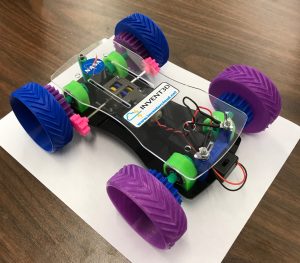
Invent2Make Projects are specially designed projects that challenge students to research, design and build items that are applied to reinforce STEAM learning. Working in teams, students create projects including miniaturized Mars rovers, gliders, birdhouses, composters, gearboxes, Noah’s Ark, musical instruments, and puppets. Students then use their creations in experiments and performances. Projects are self-paced and come with lesson plans, step-by-step resource guides, materials and CAD tutorials.
Key features of Invent2Make Projects are as follows:
- Is designed for integration into existing lesson plans
- Scalable to accommodate class needs
- Length can vary from days up to full semester
- Content can be tailored to age group and ability level
- Promotes 21st Century skills such as creativity, critical thinking, problem solving, teamwork and effective communication
- Incorporates diversity in subject matter, ranging from engineering to arts
- Provides full access to INVENT3D Maker Space resources, including design and fabrication assistance from lab staff
- Includes project kits and material supply packs to optimize teacher’s time
- Teaches students and teachers design principles through a complete set of 3D Modeling Tutorials using cloud based software
- Innovative professional development and class instruction available from Invent2Make experts in-person or online
- Provides free shipping of student projects
Vista AST will partner with your school to create a customized STEAM program to meet the current challenges of your school.
Invent2Make features five student centered learning tracks to enable teachers to customize a STEAM learning strategy for your school and students.
Student Centered Learning Paths: Summary
Many of the SCLP include the use of all-inclusive, re-usable I2M project kits that reinforce the learning content and enable student experimentation to develop data and provide input into the design of their project challenge prototype. All projects include designing and fabricating prototype solutions to the project challenges using Makerspace equipment. For more information on Invent2Make, project kits, and makerspace use, review the various pages on our website.
1. Fun with Physics
Students explore the mind of Sir Isaac Newton and his principles that form the science of physics including light, motion, and energy. They also explore the physics of buoyancy discovered by Archimedes almost 2000 years before Newton.
2. Exploring Space
Based on NASA inspired project challenges, students research and explore about space travel past and present. They learn how gravity, mass, Newton’s laws of motion, and the laws of physics impact space travel. They use sensors and program an Arduino to detect and record various scientific data on their journey across a simulated Moon’s surface.
3. The Science of Flight
Based on NASA inspired challenges, students learn the origins and physics of flight and space travel. They experiment with various forms of flight and apply Bernoulli’s principle to achieve motion. They learn about the safety considerations of space flight and program an Arduino to detect contamination and light radiation in a scaled astronaut space helmet.
4. Entrepreneurship
It has been estimated that by 2022 more than 40% of the US workforce will be independent contractors. Additionally, organizations and businesses are expecting their employees to think “entrepreneurially”, using skills such as agility, creative thinking and idea generation. Therefore, it is essential that students have the opportunity to develop the skills of the entrepreneurial mindset for career and life success even if they don’t intend to start their own business. This SCLP has been developed to provide learning opportunities and projects to reinforce these skills including preparing a business and participating in competitions.
5. Learning to Code
Coding provides a pathway for students to learn the discipline of logical and computational thinking. These projects have been designed to allow the students to advance in their coding skills and demonstrate innovation and creativity. Students begin by learning visual block coding including circuit design and simulation. In the final project, students advance to Arduino coding, providing the opportunity for them to learn to develop the code behind the block visual coding. The project challenges require an innovative solution and design build of a prototype component.
